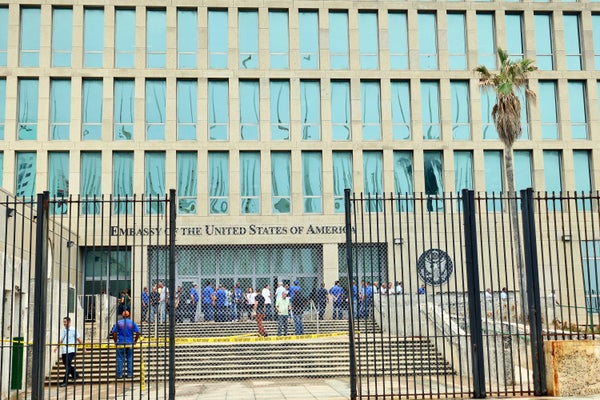Soviet-Era Pseudoscience Lurks behind ‘Havana Syndrome’ Worries
Dodgy studies and fantastic claims have long powered a belief in devious Russian brain weapons, from mind control to microwave devices
Personnel gathered at the U.S. Embassy in Cuba on September 29, 2017 in Havana, Cuba.
Sven Creutzmann/Mambo Photo/Getty Images
In the 1970s U.S. spy agencies believed that Soviet scientists were using telepathy and other supposed paranormal abilities to develop mind-control weaponry. U.S. Army and Air Force journals fretted about a “new mental battlefield” of “psychic warfare.”
If you saw The Men Who Stare at Goats, based on the nonfiction book by Jon Ronson, or read Annie Jacobsen’s Phenomena: The Secret History of the U.S. Government’s Investigations into Extrasensory Perception and Psychokinesis, then you know what happened next. The Defense Department for the next two decades squandered millions of dollars on ridiculous “psychic spy” research. It recruited paranormal enthusiasts to practice levitating and walking through walls, among other absurdities.
Most of us now chuckle at this screwball chapter of the cold war annals. But the roots of it, which can be traced to a wellspring of bogus Soviet-era studies fed to visiting American researchers and writers, is worth revisiting to better understand how the U.S. intelligence community got suckered into (and distracted by) a decades-long enchantment with the pseudoscience of parapsychology.
On supporting science journalism
If you’re enjoying this article, consider supporting our award-winning journalism by subscribing. By purchasing a subscription you are helping to ensure the future of impactful stories about the discoveries and ideas shaping our world today.
That history today offers us insight into the origin of Havana syndrome, the controversial medical condition best known for afflicting U.S. diplomats and intelligence officials. Many victims of these “anomalous health…
Read the full article here







